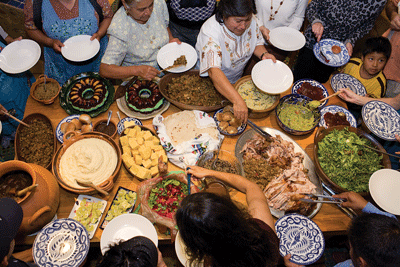
A Grand Fiesta: Mexican Thanksgiving
I've been hosting a Thanksgiving meal for most of the 20 years I've lived in Oaxaca, Mexico, where I run a cooking school on my farm, Rancho Aurora. My students come from all over the world to learn about the culinary traditions of this part of Mexico, so I don't usually stick to traditional American Thanksgiving foods. Last year, all I asked was that guests bring dishes made with ingredients native to the New World. Sixty people came to that dinner, including some of the school's former students, family visiting from the States, and local friends I'd gotten to know over the years: weavers, painters, professors, photographers, mechanics, musicians, bakers, farmers, and more.
The food they brought, served alongside dishes I had prepared, made for an unforgettable menu. We had delicious Oaxacan specialties—like espesada de guias de calabaza, a creamy squash vine soup, which we cooked in a huge cauldron—as well as less traditional dishes, like my budin de tamala y pan, a Mexican take on a Cajun-style bread pudding, made with pumpkin and plump raisins poached in mezcal. Corn, which is native to Mexico, also played a role: there was corn pudding, corn bread, and the giant white corn tortillas called tlayudas.
Many of the dishes I made were standard Thanksgiving sides accented with local ingredients and flavors. My mother always made creamed onions, for example, but never like this: I charred my onions on a grill and combined them with corn kernels and squash blossoms in a light bechamel. And I cooked sweet potatoes in a clay pot with brown piloncillo sugar, cinnamon, orange peel, chopped ginger, and slices of tangy guava. There were some interesting crossover hits, most notably my aunt Renee's Jell-O mold, which originated in Philadelphia but is actually similar to a classic Mexican gelatina.
The centerpieces of the meal were the roast turkeys, four of them, that I'd seasoned beforehand with smoked pasilla chiles, orange juice, and honey. Oaxacans love turkey—in fact, wild turkeys were domesticated in Mexico as early as the 15th century and were crossed with American breeds after that—but they typically use the meat only for stews and slow-cooked dishes like the famous Oaxacan mole negro. Many of my Oaxacan friends had never seen a turkey cooked in this way, and they marveled at the succulent and flavorful meat. I have to admit, much as I relished the regional flavor of the meal, those roasted turkeys made the day. I noticed that someone had even managed to find a few cans of cranberry sauce to go with them. —Susana Trilling, author of S_easons of My Heart_ (Ballantine Books, 1999)
Keep Reading
Continue to Next Story










